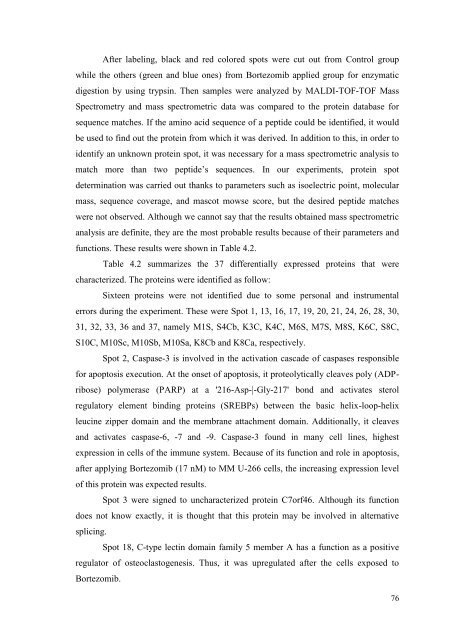changes in protein profiles in bortezomib applied multiple myeloma ...
changes in protein profiles in bortezomib applied multiple myeloma ...
changes in protein profiles in bortezomib applied multiple myeloma ...
Create successful ePaper yourself
Turn your PDF publications into a flip-book with our unique Google optimized e-Paper software.
After label<strong>in</strong>g, black and red colored spots were cut out from Control group<br />
while the others (green and blue ones) from Bortezomib <strong>applied</strong> group for enzymatic<br />
digestion by us<strong>in</strong>g tryps<strong>in</strong>. Then samples were analyzed by MALDI-TOF-TOF Mass<br />
Spectrometry and mass spectrometric data was compared to the prote<strong>in</strong> database for<br />
sequence matches. If the am<strong>in</strong>o acid sequence of a peptide could be identified, it would<br />
be used to f<strong>in</strong>d out the prote<strong>in</strong> from which it was derived. In addition to this, <strong>in</strong> order to<br />
identify an unknown prote<strong>in</strong> spot, it was necessary for a mass spectrometric analysis to<br />
match more than two peptide’s sequences. In our experiments, prote<strong>in</strong> spot<br />
determ<strong>in</strong>ation was carried out thanks to parameters such as isoelectric po<strong>in</strong>t, molecular<br />
mass, sequence coverage, and mascot mowse score, but the desired peptide matches<br />
were not observed. Although we cannot say that the results obta<strong>in</strong>ed mass spectrometric<br />
analysis are def<strong>in</strong>ite, they are the most probable results because of their parameters and<br />
functions. These results were shown <strong>in</strong> Table 4.2.<br />
Table 4.2 summarizes the 37 differentially expressed prote<strong>in</strong>s that were<br />
characterized. The prote<strong>in</strong>s were identified as follow:<br />
Sixteen prote<strong>in</strong>s were not identified due to some personal and <strong>in</strong>strumental<br />
errors dur<strong>in</strong>g the experiment. These were Spot 1, 13, 16, 17, 19, 20, 21, 24, 26, 28, 30,<br />
31, 32, 33, 36 and 37, namely M1S, S4Cb, K3C, K4C, M6S, M7S, M8S, K6C, S8C,<br />
S10C, M10Sc, M10Sb, M10Sa, K8Cb and K8Ca, respectively.<br />
Spot 2, Caspase-3 is <strong>in</strong>volved <strong>in</strong> the activation cascade of caspases responsible<br />
for apoptosis execution. At the onset of apoptosis, it proteolytically cleaves poly (ADP-<br />
ribose) polymerase (PARP) at a '216-Asp-|-Gly-217' bond and activates sterol<br />
regulatory element b<strong>in</strong>d<strong>in</strong>g prote<strong>in</strong>s (SREBPs) between the basic helix-loop-helix<br />
leuc<strong>in</strong>e zipper doma<strong>in</strong> and the membrane attachment doma<strong>in</strong>. Additionally, it cleaves<br />
and activates caspase-6, -7 and -9. Caspase-3 found <strong>in</strong> many cell l<strong>in</strong>es, highest<br />
expression <strong>in</strong> cells of the immune system. Because of its function and role <strong>in</strong> apoptosis,<br />
after apply<strong>in</strong>g Bortezomib (17 nM) to MM U-266 cells, the <strong>in</strong>creas<strong>in</strong>g expression level<br />
of this prote<strong>in</strong> was expected results.<br />
Spot 3 were signed to uncharacterized prote<strong>in</strong> C7orf46. Although its function<br />
does not know exactly, it is thought that this prote<strong>in</strong> may be <strong>in</strong>volved <strong>in</strong> alternative<br />
splic<strong>in</strong>g.<br />
Spot 18, C-type lect<strong>in</strong> doma<strong>in</strong> family 5 member A has a function as a positive<br />
regulator of osteoclastogenesis. Thus, it was upregulated after the cells exposed to<br />
Bortezomib.<br />
76

















